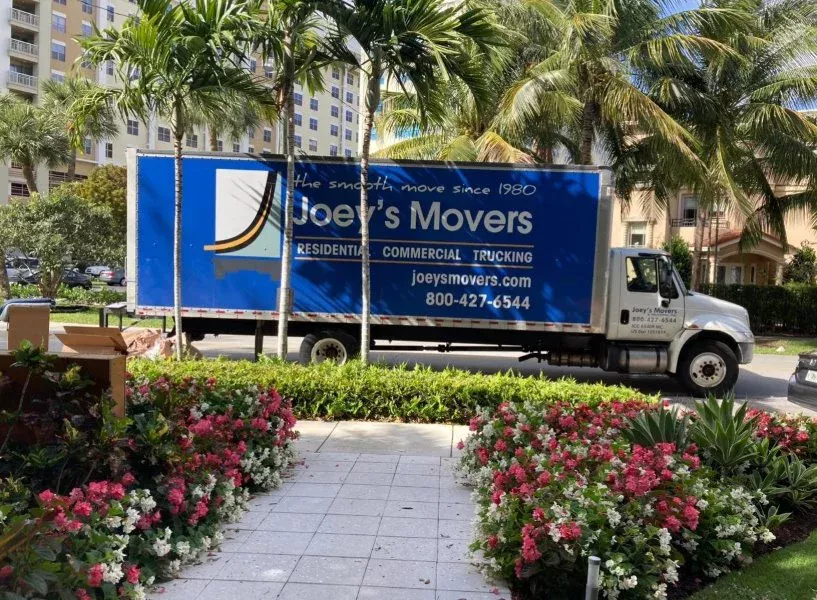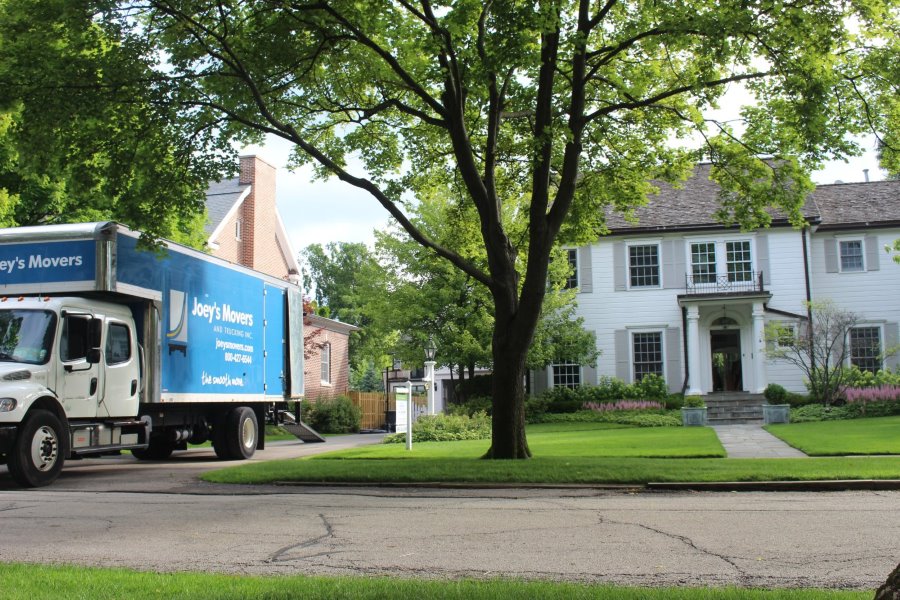Moving to a new home is always exciting, but the devil is in the details, even when it comes to the basics of what type of home you want to move into. Townhouse vs condo is one of the most common dilemmas for people in the Chicagoland area. As moving professionals with over forty years of experience in Chicago’s city and surrounding suburbs, we’ve helped countless clients relocate to both types of properties, lending us unique insights into each one’s distinct characteristics and the specific needs of each when it comes to the moving process.
Before diving into the structural difference between a townhouse and a condo, let’s address a significant distinction that few people understand: While townhouses are defined by their physical structure and layout, condos are strictly defined by their ownership model. A condo can be any type of property, from a one-bedroom unit in a larger multi-family building to a townhouse to a single-family home in a neighborhood. What defines a property as a condo is that its owners typically own everything within their unit’s walls, while the exterior and common areas are collectively owned.
Defining Townhouses and Condos
What is a Townhouse?
A townhouse is a multi-story home that shares one or more walls with adjacent properties. Though every townhouse community is different, and styles have changed over the years, many aspects remain the same from one to the other.
Townhouses typically feature:
- Individual entrances and multiple floors
- Shared walls with neighboring units
- Private outdoor spaces (front yard, backyard, or both)
- Attached or dedicated parking spaces
- Direct street access
From an ownership perspective, people who own townhouses generally own both their unit’s interior and exterior, including the land it sits on. This ownership structure influences everything from maintenance responsibilities to moving logistics.
What is a Condo?
A condominium, or condo, is a private residence within a larger building or community, be it a high rise, a townhouse community, or a neighborhood of single-family homes. The defining characteristic of a condo is its ownership structure rather than its physical form.
Key features include:
- Individual unit ownership within a larger complex
- Shared common areas and amenities
- Professional property management
- Structured parking facilities
- Condos in high-rise buildings typically have elevator access
- May be single or multi-level units
Condo owners generally own everything within their unit’s walls while sharing ownership of common areas with other residents through an HOA, or Homeowners Association.
Key Differences Between Townhouses and Condos
Ownership and Maintenance Responsibilities
Among the biggest distinctions in the condo vs townhouse question is ownership and maintenance. Townhouses have ownership of both the inside and the outside of the property, and also carry the greater maintenance responsibilities of the two.
Townhouse owners are typically responsible for:
- Interior maintenance and repairs of their unit
- Exterior maintenance of the roof, siding, and windows of their unit
- Yard maintenance and landscaping
- Snow removal where applicable
- Pest control
- Property insurance for both the structure and its contents
Condo owners are usually responsible for:
- Interior maintenance and repairs of their unit
- Appliances within their unit
- Personal property insurance for their unit’s contents
- Minor plumbing issues within their unit
HOA Fees and Regulations
When weighing the question of townhouse vs. condo, the monthly HOA fees you’ll be required to pay are an important consideration. The structures and services provided by the two types differ significantly, and so can the cost:
Condo HOA fees are typically higher than those for townhouses due to shared amenities and maintenance of common areas. They generally cover:
- Building exterior maintenance
- Common area maintenance
- Building insurance
- Security systems
- Amenity maintenance
- Professional management
- Some utilities
Townhouse HOA fees generally cover:
- Limited common area maintenance
- Community amenities
- Snow removal where applicable
- Trash removal
- Basic landscaping of common areas
Privacy and Space Considerations
Privacy levels vary significantly between these property types, with townhouses typically offering more privacy, unless the condo is a single-family unit.
Townhouses offer:
- Fewer shared walls (typically only on two sides, with end units only sharing a single wall)
- Private outdoor spaces
- Multiple floors for better separation of living spaces
- Often have more square footage
- Direct street access
Condos typically feature:
- More shared walls (potentially on multiple sides), though not always
- Shared common areas
- Community amenities
- Limited private outdoor space
- Controlled access to the building where applicable
Moving Cost Comparison
Average Moving Costs
Moving costs vary based on many different factors, including what and how much is being moved, the distance being moved, and the quality and experience of the mover. They can also vary significantly between townhouses and condos.
Townhouse moving costs and considerations often include:
- Multiple-floor transportation with higher labor costs ($75-150 additional per floor)
- Longer moving times due to stairs
- Potential yard access fees or “long carry fees”
Condo moving costs and considerations typically involve:
- Elevator reservation fees ($50-250, plus deposit)
- Loading dock scheduling
- Shorter windows for moving times due to consolidated spaces
- Additional insurance requirements
Potential Hidden Fees
Another important townhouse vs condo consideration is the additional costs and requirements of the move itself. At first glance, you might think the costs would be the same, but it’s not always that straightforward. Whether you’re moving into a townhouse or a condo, it’s a good idea to ask ahead of time about the following.
Townhouse hidden fees and requirements:
- HOA move-in fees ($100-500)
- Street parking permits for moving trucks
- Landscape damage deposits
- Gate access fees for gated communities
Condo hidden fees and requirements:
- Building move-in fees ($200-1000)
- Elevator deposits ($500-1000, refundable)
- Certificate of Insurance
- Loading dock scheduling and scheduling fees
- After-hours moving fees
Logistical Considerations During Moving
Accessibility Challenges
Each property type presents unique accessibility considerations with the potential to make your move more costly or challenging.
Condos:
- Elevator scheduling requirements
- Limited loading dock hours
- Strict moving time windows
- Distance from parking to unit may lead to long-carry charges
- Security access protocols
Townhouses:
- Narrow staircases
- Multiple floor navigation
- Limited street parking
- Tight corners and hallways
- Yard access considerations
Parking and Proximity for Moving Trucks
Moving truck accessibility varies significantly between townhouses and other types of condo buildings. It’s a good idea to identify any challenges ahead of time to avoid unforeseen complications.
Townhouse considerations:
- Street parking availability
- Distance from truck to entrance
- Yard access for equipment
- HOA restrictions on truck size
- Time limitations for street parking
Condo considerations:
- Loading dock availability
- Height restrictions in parking structures
- Designated moving areas
- Time restrictions for loading zones
- Distance to service elevators
Long-Term Storage Needs
Space Availability
Storage options differ between townhouses and condominium properties.
Townhouses frequently offer:
- Attached garages
- Basements or attics
- Multiple closets
- Under-stair storage
Condos frequently provide:
- Limited closet space
- Possible storage lockers
- Shared bike storage
- No attic or basement
- Limited garage storage
Off-Site Storage Considerations
Having enough storage for all of your belongings is a common consideration, no matter what type of structure you live in, but people moving into townhouses and condos frequently have extra factors driving the need for external storage.
Townhouse residents might need external storage for:
- Seasonal items
- Recreational equipment
- Extra vehicles
- Home improvement materials
- Storage during renovations
Condo residents often require storage for:
- Seasonal clothing
- Sports equipment
- Holiday decorations
- Extra furniture
- Personal collections
Frequency of Relocation
When you’re calculating the costs of a move, it’s always a good idea to factor in the amount of time you believe you’ll be staying in your new location. While it’s impossible to predict the future, the following statistics may be helpful.
Ownership Duration Trends
Based on industry data, townhouse owners typically stay for 7-10 years while condo owners average a slightly shorter amount of time, staying from 5-7 years in their unit. Investment properties show shorter durations, while first-time buyers often transition to a new property within 3-5 years.
Impact on Moving Frequency
These trends may seem like isolated statistics, but they have an impact on several different aspects of the costs of a move. The higher turnover rate in condos has led to more flexible scheduling, as buildings need to be more accommodating of owners’ needs. Moving expenses for people moving into and out of a townhouse often involves more possessions and furniture than a condo, and that means higher costs, including long-term storage expenses, which are more commonly incurred by townhouse owners.
Special Moving Considerations
Structural Challenges
Each property type presents its own unique structural challenges.
Townhouse challenges typically include:
- Multiple floors
- Narrow staircases that limit furniture size
- Tight corners in hallways
- Complex room layouts
Condo challenges typically include:
- Elevator size restrictions
- Limited unloading areas
- Shared space navigation
- Time constraints
- Building access protocols
Building Regulations and Restrictions
Each type of structure encounters its own moving restrictions.
Townhouse regulations often include:
- HOA-approved moving hours
- Parking restrictions
- Exterior protection requirements
- Noise limitations
- Landscape protection requirements
Condo regulations often include:
- Strict moving schedules
- Insurance requirements
- Professional mover mandates
- Elevator reservations
- Security protocols
HOA Rules Impacting Moves
HOAs offer many benefits and are important to the maintenance of important standards within a community, but they can also be restrictive, including imposing strict rules surrounding move-ins and move-outs.
Move-In/Move-Out Policies
Typical move-in and move-out policies for townhouses include:
- Moving notification requirements
- Parking permits
- Damage deposits
- Time restrictions
- Contractor insurance requirements
Typical move-in and move-out policies for condos include:
- Scheduled moving windows
- Coordination with building or community security
- Elevator reservations
- Advanced scheduling of loading dock
- Certificate of Insurance
Compliance Requirements
Whether you’re planning a move into a townhouse or a condo, ensuring a smooth process means paying attention to the requirements imposed by the HOA. Make a checklist of what is being asked of you and be ready with all documentation, which may include:
- Moving company insurance certificates
- Building access forms
- Parking permits
- Elevator reservations
- Damage deposits
Frequently Asked Questions
What is the difference between a condo and a townhouse?
There are many differences, but the main difference lies in ownership structure. Townhouse owners typically own both their unit’s interior and exterior, including the land, while condo owners own their unit’s interior and share ownership of common areas through an HOA.
Is a condo or a townhouse a better investment?
The answer to that question depends on your goals. Townhouses often appreciate more due to land ownership, but they also require more time and money for maintenance. Condos typically have lower maintenance responsibilities but higher HOA fees. Both can be good investments, so when deciding between the two, focus your attention on your budget and the amount of time you want to put into maintenance, as well as local market conditions and whether you’ll be happy living there.
Should I live in a condo or a townhouse?
Your lifestyle and preferences should guide this choice. Choose a condo if you prefer minimal maintenance responsibilities, access to amenities, the excitement of high-rise, downtown life, and enhanced security features.
Alternatively, choose a townhouse if you prefer multi-level living, greater privacy, access to your own outdoor space with a neighborhood feel, and greater control over your property and its maintenance.
Are condos safer than townhouses?
Condos often offer additional security features like controlled access, security staff, and cameras in common areas. However, townhouses can be equally secure with proper security systems and neighborhood watch programs. Both property types can provide safe living environments.
Conclusion
There are a lot of elements to be weighed when assessing a townhouse vs condo. Townhouses typically offer more space and privacy but come with increased maintenance responsibilities, while condos provide convenience and amenities but may have stricter moving regulations and less storage space. Choosing between the two is a matter of your personal preferences, budget, and market availability. Whichever direction you go, understanding the differences detailed above can make a real difference between a stressful process and a smooth, successful move.
Joey’s Movers has been providing Chicagoland with professional, responsive moving services for over forty years. Our customers rely on our high level of customer service, attention to detail, and experience to help them manage the unique challenges of moving into all types of properties.
Ready to plan your move? Our experienced team will help you navigate the specific requirements of your new home, ensuring a smooth transition whether you choose a townhouse or condo. Contact Joey’s Movers today for a free quote tailored to your specific property type and moving needs. We’ll help you with all the logistics, ensuring a seamless relocation to your new home.



